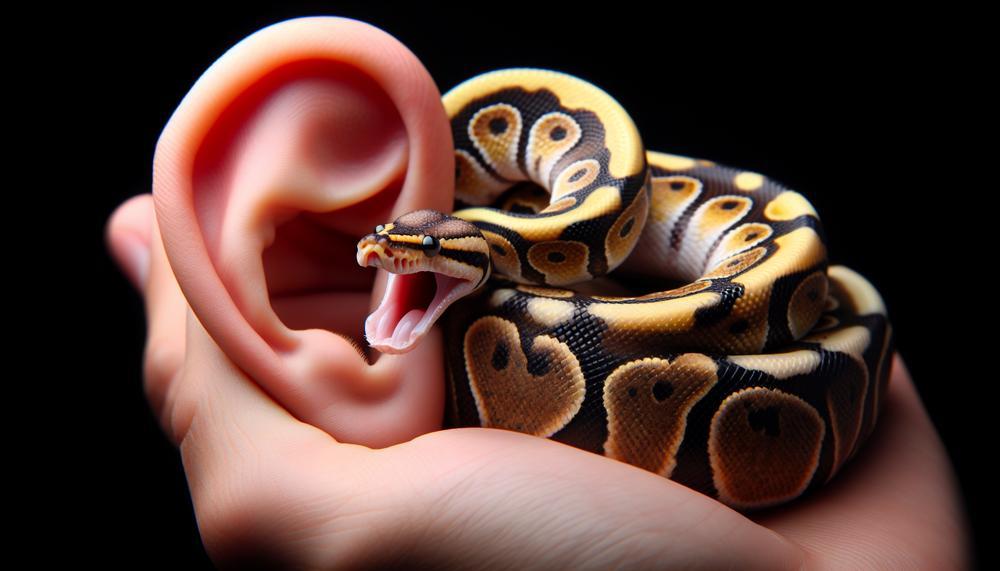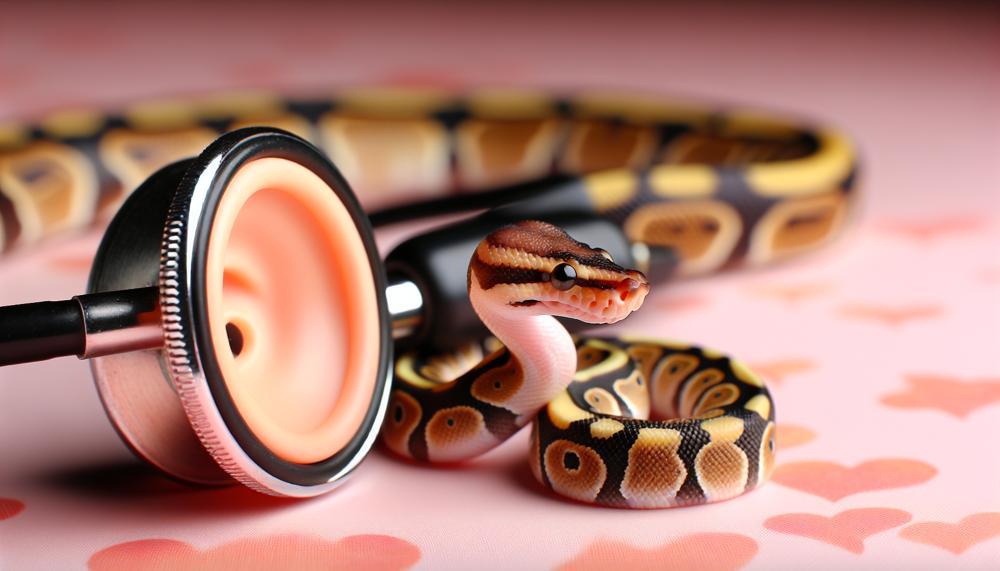These beloved pet snakes are renowned for their striking patterns and gentle demeanor, but did you know they possess a remarkable sense of hearing?
It’s true – despite lacking external ears like humans, ball pythons have evolved unique mechanisms for perceiving sound.
Prepare to be amazed by these intriguing facts about their auditory abilities:
- Through their jawbones, ball pythons can detect low-frequency vibrations, allowing them to sense the movement of prey or predators.
- Their specialized organ, the columella auris, enables them to pick up high-frequency sounds with precision.
- This acute sense of hearing also allows them to communicate with other snakes through hissing and growling.
- In the wild, ball pythons can hear sounds from great distances, making them skilled hunters.
- As pets, they may even respond to familiar voices or music played at moderate volumes.
So let’s delve deeper into the realm of ball python hearing and uncover more astonishing facts about these mesmerizing creatures.
Contents
Can Ball Pythons Hear?
While they may not have external ears like humans, these sneaky serpents possess a special sound wave detection system that allows them to sense airborne and ground vibrations. This enables them to detect sounds and communicate with other snakes, making them quite the social creatures.
However, unlike humans, they cannot hear actual sounds due to the absence of an eardrum.
| Organ | Function | Importance |
|---|---|---|
| Inner Ear Systems | Aids in detecting sound waves through vibrations in the air and ground | Essential for hearing in ball pythons |
| Quadrate Bone | Helps with sound wave detection in jaws | Contributes to their ability to hear through vibrations |
| Eardrum | Lack of external eardrum prevents them from hearing actual sounds | Not essential for their survival but limits their ability to hear as humans do |
| Special Sound Wave Detection System | Allows them to sense both airborne and ground vibrations | Crucial for detecting predators and communicating with other snakes |
In fact, ball pythons have an intricate hearing system that includes inner ear systems, the quadrate bone, and a special sound wave detection system. These components work together to detect vibrations in order to hear and communicate with others.
For example, when a snake slithers across the ground, it creates vibrations that can be picked up by their unique hearing mechanism. This not only helps them navigate their environment but also allows them to communicate with other snakes, whether it be for mating or warning of danger.
The Inner Ear System of Ball Pythons
Ball pythons are known for their incredible ability to sense vibrations and potentially hear sounds, thanks to their unique inner ear system.
Unlike other animals that possess external ears, ball pythons have a highly specialized system that allows them to detect vibrations and potentially hear sounds through a combination of vibration sensing, airborne hearing, and using their entire body as a sensory tool.
This complex system involves the quadrate bone in their lower jaw and other connected bones, which transmit vibrations to their inner ear.
Recent research has also revealed that ball pythons may use airborne hearing to detect sound waves vibrating their skulls, expanding their range of sound detection capabilities.
External Ears: None Visible, But Highly Effective
Unlike most animals that have visible external ears, ball pythons do not possess them. Instead, they have evolved a unique inner ear system that is highly efficient in detecting vibrations and sounds in their surroundings.
This unique adaptation allows them to pick up on low-frequency sounds from far distances and even sense some human speech tones (80-180 Hz), bass guitar notes below 262 Hz, and loud noises like barking or drums within a limited hearing range of 80-1000 Hz.
Quadrate Bone: The Key Component in Their Hearing System
The quadrate bone in the lower jaw of ball pythons plays a crucial role in their hearing system. This small but mighty bone is connected to other bones that transmit vibrations to their inner ear, allowing them to sense vibrations and potentially hear sounds.
It is this unique adaptation that gives ball pythons an advantage in detecting sounds in their environment.
Airborne Hearing: A Potential for Greater Sound Detection
Recent research has shown that ball pythons may also use airborne hearing to detect sound waves vibrating their skulls. This not only expands their range of sound detection capabilities but also showcases the complexity and effectiveness of their hearing system.
With this ability, ball pythons can pick up on low-frequency sounds from far distances, giving them a better chance at survival in the wild.
Whole Body Sensory Tool: A Creative Solution to Lack of External Ears
One of the most fascinating aspects of the inner ear system of ball pythons is their ability to use their entire body as a sensory tool. Due to the lack of external ears, ball pythons have adapted to use their entire body to detect sound.
This unique adaptation not only showcases their incredible abilities but also highlights the importance of understanding and appreciating these amazing creatures.
Differences Between Human and Ball Python Hearing
The hearing abilities of humans and ball pythons differ significantly due to their anatomical and physiological differences. While both species have the ability to hear, they do so in very different ways.

Let’s take a closer look at the main differences in hearing abilities between humans and ball pythons.
| Aspect | Human Hearing | Ball Python Hearing |
| Ear structure | Humans have visible external ears, a middle ear with three small bones, and an inner ear. This complex ear structure allows them to hear a wide range of frequencies. | On the other hand, ball pythons lack visible external ears and have a unique inner ear structure that allows them to sense vibrations in their environment. |
| Range of frequencies they can hear | The human hearing range is quite extensive, ranging from 20 Hz to 20,000 Hz. However, the most sensitive range is between 2,000-5,000 Hz. | In comparison, ball pythons have a more limited hearing range of 80-1000 Hz and are more sensitive to low frequencies. |
| Sensitivity to sound | Humans have a higher sensitivity to sound compared to ball pythons, especially in the range of 500-4,000 Hz. | While humans are more sensitive to mid-range frequencies, ball pythons are more sensitive to low frequency sounds. They rely on vibration sensing to determine where sound comes from and what it is. |
| Ability to distinguish words or high cries | Due to their complex auditory system, humans can easily distinguish words and high-pitched sounds. | However, ball pythons cannot distinguish words or high-pitched sounds as they rely on vibration sensing rather than external ears. |
| Noise tolerance | Humans can tolerate a wide range of noises, including loud ones, without being significantly stressed. This is due to their advanced hearing capabilities. | In contrast, ball pythons are more sensitive to loud noises and excess noise can significantly stress them out. |
The Importance of Sound Detection for Ball Pythons
Ball pythons have a remarkable ability to detect sound, which plays a vital role in their survival in the wild.
Their keen sense of hearing allows them to hunt, socialize, and avoid danger effectively.
Hunting:
One of the primary uses of ball pythons’ hearing abilities is for hunting. They can sense vibrations in the air using their inner ear, which helps them locate potential prey such as small mammals and birds. This unique skill allows them to be efficient hunters, especially at night when visibility is limited.
Socializing:
In addition to hunting, ball pythons also use their hearing abilities for socializing with other snakes. They produce low-frequency sounds that are inaudible to humans but can be detected by other snakes.
This allows them to communicate and establish dominance within their group.
Avoiding danger:
In the wild, ball pythons face numerous dangers, including predators and natural disasters. However, their hearing abilities provide them with an advantage by allowing them to detect vibrations caused by nearby predators or earthquakes.
This enables them to escape danger quickly and effectively.
Communication:
Although they are generally known to be quiet and non-vocal, ball pythons do make faint hissing sounds when breathing close to their mouth or nose. This could be a form of communication with other snakes or a warning signal to potential predators.
The Significance of Sound Detection:
Overall, the hearing abilities of ball pythons are crucial for their survival in the wild. Without this sense, they would struggle to hunt, communicate, and avoid danger effectively.
Therefore, as responsible pet owners, it is essential to provide a peaceful and quiet environment for our ball pythons to thrive and maintain their natural hunting instincts.
Caring for Your Ball Python’s Hearing in Captivity
While snakes do not possess external ears like humans, they do have a well-developed inner ear that allows them to perceive sounds and vibrations.
To maintain your ball python’s hearing health while in captivity, there are several measures you can take:
- Avoid loud noises: Ball pythons are sensitive to loud noises and sudden sounds. These noises can cause stress and discomfort for your snake, leading to potential health problems. It is crucial to keep their habitat quiet and peaceful.
- Monitor for hissing behavior: Hissing is a sign of unease or stress in snakes. If your ball python is frequently hissing, it may be a warning that the environment is too noisy for them.
- Do not cohabitate with other snakes: As previously mentioned, hissing is also a defense mechanism in snakes. If two ball pythons are housed together and start hissing at each other, this could indicate aggression and they should be separated immediately.
- Create a comfortable living space: Snakes require specific temperature and humidity levels to thrive in captivity. Incorrect levels can cause stress and impact their overall well-being, including their hearing. Be sure to research the ideal conditions for your ball python’s species and provide a suitable habitat.
- Observe their behavior: Regularly observing your snake’s behavior can help you understand what is normal for them and identify any changes or abnormalities. If you notice any changes in their behavior, it could be a sign of discomfort or illness.
Providing a Suitable Environment for Sound Detection
Creating a suitable environment for sound detection in ball pythons is crucial for promoting their ability to hear and respond to sounds. This involves establishing a healthy, naturalistic setting that minimizes loud noises and avoids cohabitation with other snakes.
Additionally, providing a comfortable living space and incorporating a bioactive setup can greatly enhance their sound detection abilities.
Regular observation and monitoring of their behavior is also important in maintaining their hearing health. Let’s delve deeper into these factors and how they contribute to creating an optimal environment for sound detection in ball pythons.
Minimizing Loud Noises:
Ball pythons have sensitive hearing and can easily be disturbed by loud noises.
Therefore, it is essential to keep their living space in a quiet area, away from any sources of noise such as televisions or loud household appliances. Loud noises can cause stress and discomfort for the snake, leading to behavioral changes and potential hearing damage.
A peaceful and serene environment is crucial for promoting their sound detection abilities.
Avoiding Cohabitation with Other Snakes:
It is not recommended to house multiple snakes together as this can lead to competition and aggression. When snakes are kept in the same enclosure, they may hiss at each other, causing stress and potential harm to their hearing.
It is best to provide each snake with their own separate living space to avoid any conflicts that may affect their hearing health.
Creating a Comfortable Living Space:
A suitable environment for sound detection should also include a comfortable living space for the snake. This includes providing adequate hiding places and appropriate substrate for burrowing.
A cozy and secure living space reduces stress and promotes a sense of well-being for the snake, allowing them to better focus on detecting sounds in their surroundings.
Incorporating a Bioactive Setup:
A bioactive setup can greatly benefit ball pythons by providing enrichment, self-cleaning, and an interactive environment. This setup mimics their natural habitat and encourages exploration and activity in the snake.
The inclusion of plants and detrivores also helps to maintain a healthy and balanced ecosystem, which can enhance the snake’s ability to detect sound. This bioactive setup not only promotes their hearing health but also increases their overall well-being.
Regular Observation and Monitoring:
It is crucial to regularly observe and monitor the behavior of your ball python to ensure their hearing health. Any changes or abnormalities in behavior may indicate potential hearing issues, and prompt action should be taken to address them.
This includes seeking veterinary care if necessary. Regular observation also allows for early detection of any potential problems, ensuring timely intervention and treatment.
Also Read: Are Corn Snake Crepuscular?
Conclusion
In conclusion, while ball pythons may not have external ears like humans, their inner ear system allows them to possess a remarkable sense of hearing.
Through low-frequency vibrations, they can communicate with other snakes through hissing and growling. In the wild, they are able to hear sounds from great distances and as pets, they may even respond to familiar voices or music.
Creating a suitable environment for sound detection is crucial for their well-being. This includes minimizing loud noises, avoiding cohabitation with other snakes, providing a comfortable living space, incorporating a bioactive setup, and regularly monitoring their behavior.
Despite common misconceptions about their hearing abilities, ball pythons have evolved unique mechanisms for perceiving sound that are vital for their survival in the wild.






